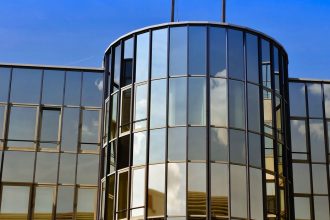As global awareness of environmental issues grows, the construction industry is undergoing a significant transformation. Building practices are increasingly embracing sustainability, driven by the urgent need to mitigate climate change, reduce waste, and create healthier living environments. This post will explore how eco-friendly materials and innovative practices in green building design are reshaping modern construction and sustainable real estate development. We will also delve into initiatives like the Living Building Challenge and other pioneering movements that are leading this green revolution.
The Shift Towards Eco-Friendly Materials
Why Sustainability Matters in Construction
The construction sector is responsible for approximately 39% of global carbon emissions, with building operations contributing a significant portion to this statistic. As such, the transition toward sustainable materials is critical for reducing the industry’s carbon footprint. Eco-friendly materials not only minimize environmental impact but often enhance the quality and longevity of buildings.
Key Characteristics of Eco-Friendly Materials
-
Renewability: Materials like bamboo, cork, and reclaimed wood are renewable resources that minimize the ecological impact of deforestation.
-
Recyclability: Many green materials can be recycled or repurposed, reducing landfill waste. Steel and certain types of glass are prime examples.
-
Low Volatile Organic Compounds (VOCs): Many eco-friendly paints, adhesives, and finishes release fewer VOCs, creating healthier indoor air quality.
- Energy Efficiency: Insulation materials such as cellulose (made from recycled paper) and sheep’s wool improve energy efficiency by reducing the need for heating and cooling.
Examples of Eco-Friendly Materials
-
Hempcrete: This sustainable building material is made from hemp fibers mixed with lime. It is lightweight, pest-resistant, and offers excellent insulation properties.
-
Recycled Steel: Using recycled steel for structural components greatly reduces the energy costs associated with producing new steel and diverts waste from landfills.
- Straw Bale: This resource enables high levels of insulation while being inexpensive and renewable.
Innovative Practices in Green Building Design
Innovative design strategies are essential for improving sustainability in construction. The integration of eco-friendly materials is just one part of the broader spectrum of green building practices. Here are some innovative processes being adopted.
Passive Design Strategies
Passive design takes advantage of the local climate to maximize comfort while minimizing energy use. Techniques include strategic placement of windows for natural ventilation, overhangs for sunshade, and thermal mass materials that regulate indoor temperatures.
Water Management Systems
Water efficiency is integral to sustainable construction. Green roofs, rainwater harvesting systems, and greywater recycling are examples of innovative plumbing systems designed to conserve water and reduce runoff.
Smart Technology
The integration of smart technology enhances energy efficiency and operating performance for buildings. Automated systems can control lighting, heating, and cooling, ensuring efficient energy use. These technologies not only enhance convenience but also contribute to significant resource savings over time.
Biophilic Design
A growing trend in sustainable design is biophilia, which draws inspiration from nature. Features such as indoor gardens, natural light optimization, and the use of natural materials help create spaces that promote well-being, connecting occupants more closely with the environment.
The Living Building Challenge
One of the most ambitious sustainable building initiatives is the Living Building Challenge (LBC). Established by the International Living Future Institute, LBC sets criteria that exceed conventional green building standards, requiring buildings to be:
-
Net Zero Energy: Buildings must produce as much energy as they consume on an annual basis, often achieved through on-site renewable energy sources like solar panels.
-
Net Zero Water: Buildings must capture and treat all the water they use, making them completely self-sufficient in terms of water supply.
-
Materials Petal: This aspect promotes the use of non-toxic, sustainably sourced materials, prioritizing transparency in the sourcing and manufacturing processes.
- Wellness and Beauty: The challenge also encourages designs that promote health and well-being, as well as aesthetic quality.
Notable Examples
-
Bullitt Center in Seattle, WA: Often referred to as the greenest commercial building in the world, the Bullitt Center meets LBC’s rigorous standards and features a solar array that generates more energy than it consumes.
- Living Home by Fred Keeble: A residence designed to meet LBC criteria, incorporating salvaged materials, renewable energy systems, and regional materials, highlighting the possibility of sustainable single-family homes.
The Future of Sustainable Real Estate Development
As we look toward the future, several trends reinforce the importance of sustainability in real estate development:
-
Regulatory Support: Many cities are beginning to mandate or offer incentives for green building practices, ranging from energy efficiency requirements to waste reduction targets.
-
Market Demand: More consumers and businesses prioritize sustainability in their purchasing decisions, leading to an increased demand for eco-friendly developments.
-
Corporate Responsibility: Leading companies are setting goals for sustainability, such as reducing carbon emissions and improving energy efficiency across their holdings.
- Collaboration and Education: Knowledge sharing among professionals in the industry is growing, promoting best practices in eco-friendly construction and fostering a culture of sustainability.
Conclusion
The construction and real estate sectors are on the precipice of a green revolution that merges eco-friendly materials with innovative building practices. Initiatives like the Living Building Challenge are redefining what is possible, driving the industry toward greater sustainability. As these trends continue to evolve, they offer a tantalizing glimpse of a future where buildings are not just structures but integral parts of a harmonious ecosystem. Embracing these changes is not merely a responsibility but also an exciting opportunity for architects, builders, and developers to create a more sustainable world.







